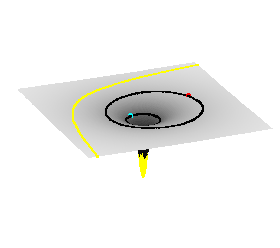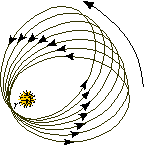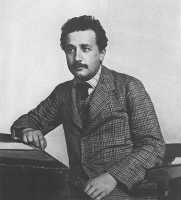9.4 The General Theory of Relativity
(Discovering the Universe, 5th ed., §13.2)
- The equivalence of mass and energy soon led Einstein to develop
the General Theory of Relativity, published in 1916.
Light has no mass, but it does have energy, so it should be affected
by the presence of massive objects such as the Sun, just as the
planets are.
- The General Theory of Relativity is based on a four-dimensional
geometric framework of space and time called space-time.
Space-time is not an emptiness, but instead has a physical presence
that is affected by its contents.
The predictions of General Relativity include:
 The
presence of mass or energy will curve space. The
presence of mass or energy will curve space.
You can think of space as a three-dimensional "rubber sheet"
that is usually flat.
But when a mass is placed on this "rubber sheet", it
stretches and curves in response.
When space is curved, a moving object must follow the curvature,
i.e. change its speed and direction, just as a car must turn
when the highway curves.
Curvature of space thereby replaces Newton's concept of force
as a means to accelerate objects.
The gravity
well takes on a new physical meaning, with the massive Sun
sitting at its bottom, and the planets forced to curve around
the walls of the well.
Light must also curve around a massive object such as the Sun
(see the yellow line in the picture above).
Question: what shape will
light's path have?
 The deflection
of light near the Sun was verified during the solar eclipse of
1919, when a star that should have been invisible behind the
eclipsed Sun could be seen. The deflection
of light near the Sun was verified during the solar eclipse of
1919, when a star that should have been invisible behind the
eclipsed Sun could be seen.
The observed amount of deflection, 1.75 arc sec, is the same
as that predicted by General Relativity.
- The presence of mass or energy will slow down time.
In other words, clocks run more slowly near a massive object, another form of time dilation.
Atomic clocks can detect a time difference between the bottom and top of a tall building!
 Time dilation near the Sun explains why Mercury's orbit precesses. Time dilation near the Sun explains why Mercury's orbit precesses.
Recall that angular momentum is given by
AM ~ mr2/P
AM is a conserved quantity, and the perihelion distance r doesn't change, either.
So P, the time per orbit, must also be fixed.
But time must dilate in the vicinity of the Sun, which means the orbit must become longer, i.e. the perihelion shifts its position in the direction of motion.
The observed amount of perihelion shift, 43 arc sec/century, is the same as that predicted by General Relativity.
- Newton's Laws of Motion and Law of Gravitation are approximations to General Relativity that are only applicable away from large masses or other concentrations of energy.
In other words, General Relativity is a generalization of Newton's Laws of Motion and Gravitation.
In practice, one must have an escape velocity faster than ~0.1c to observe these general relativistic effects.
Nevertheless, with sensitive experimental equipment such as atomic clocks, the predictions of General Relativity have been verified to high precision.
|
